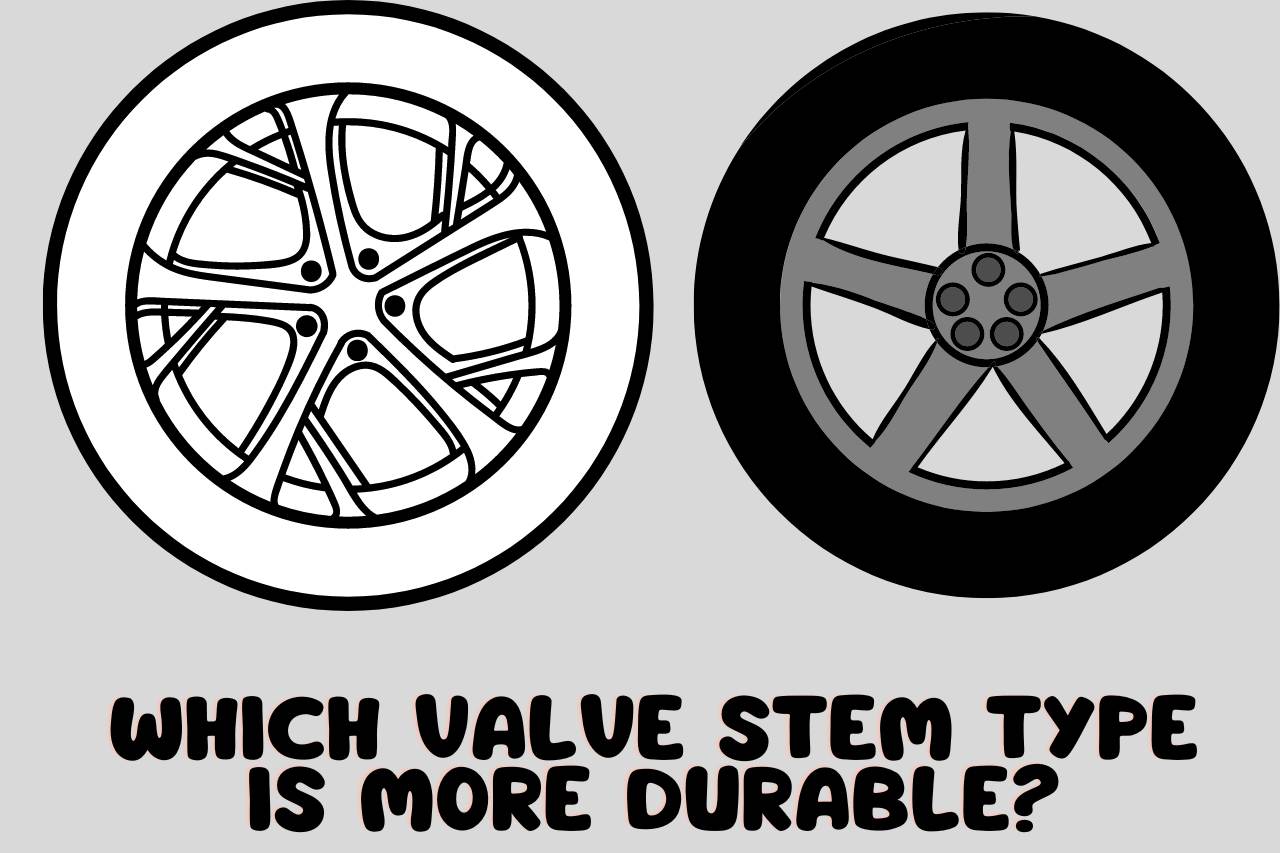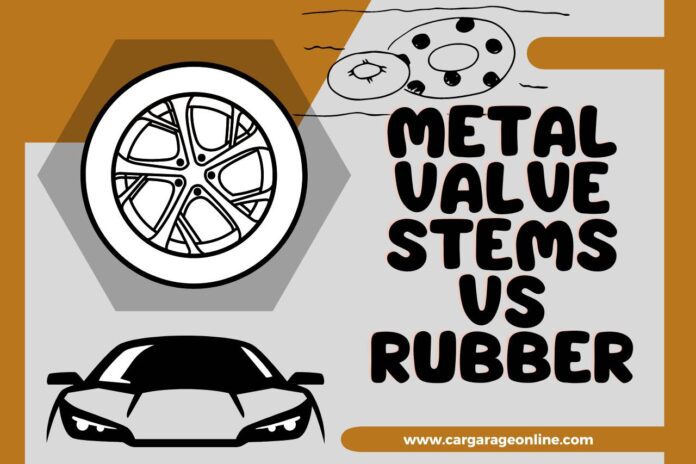This article focuses on the two Schrader valves essential to maintain the air pressure in the tires; the two standard valve stems are the metal and rubber valve stems. Both valve stems are excellent choices, but their properties, features, and uses make them unique for different purposes. The rubber valve stems are used to prevent leaks allowing them to pressurize the tires, while metal valve stems are just as great at doing the job but lack the durability the Rubber stems possess. The article will cover what rubber and metal stem valves are, which stem is more durable, which can resist high temperatures, and Metal valve stems vs Rubber.
What Are Metal Valve Stems?
The valve stems on a tire helps the tire hold in air and stay inflated, and adjust and deflate as necessary. The metal valve stems are usually aluminum, steel, or brass.
This makes them durable enough to withstand extreme temperatures, corrosion, dirt and debris, and other vibrational impacts.
Metal valve stems are popular for their appearance and ability to withstand pressure longer due to durability. These metal valves are very expensive compared to rubber valves offering a longer lifespan worth the money spent.
The components and parts of the metal valve stem can last nearly five times more than those of Rubber. Use metal valve stems to protect yourself from ozone degradation and water intrusive challenges.
Pros and Cons of Metal Valve Stem
Pros
- The metal valve stems are much less likely to get damaged. Leaked or blow-off under extreme and heavy use.
- Metal valve stems are identified to be much stronger, so they provide an efficient sealing capability, which allows for minimum air leaks.
- These valves are versatile and can be adjusted more easily when it comes to different levels of inflation pressure.
- These items are also very easy to replace during punctures and other damages to the tire and components; for this, you only need to unscrew the metal valve from the rim and replace it with a new one. Whereas for rubber valves, you will have to cut them off.
- Metal ones are known for their extreme air pressure and speed, which are attractively 200psi and 130 mph+ respectively.
Cons
- Just as much as they have speed and strength, they also can rust when exposed to moisture and water. This requires the need to replace it frequently.
- These valves can be less flexible, making them less efficient in tightening the seal than Rubber. This leads to premature breakdown and also quick wear and tear of the structure.
- These stems are very less durable compared to Rubber due to the corrosion, the shorter lifespan of the seal, and the lack of flexibility.
- These metal stems require torque to lock the nuts, making installation a little complicated.
- Another disadvantage or consequence of using these metal stems is how expensive they can be to purchase.
What Are Rubber Valve Stems?
Rubber stems, just like the metal valves, are basic components that are used to trap the air inside the tires to keep them inflated. You can see the rubber valve stem on the tire rims or wheel. Both these valve stems help reduce and add air into the tire as required.
The rubber valve can actually hold the pressure inside at least 65 psi. This Rubber stems can be observed ideally in light-duty vehicles and passenger cars, while the metal valves can be seen in heavy-duty vehicles like container trucks and trailers.
Even though this valve stems are not as popular for their appearance, they are much more durable and do not wear off or corrode as metal stems.
Pros and Cons of Rubber Valve Stems
Pros
- These rubber valves are very unlike to corrode over time. These valves are quite known for their durability but can wear off under certain conditions much faster.
- They have a longer lifespan, unlike metal caps, as they do not wear and tear easily. These are also very flexible and can tightly seal the air in with much effectiveness.
- These valves are much easier to inflate and also deflate due to their larger diameter.
- Rubber stems are much more economical and cheaper to afford compared to fancy-looking metal stems.
Cons
- One drawback to using them is difficulty installing compared to the metal valves, and this happens because of the flexibility of the Rubber making it less sturdy when fixing.
- These require replacement in a much shorter time span than metal unless metal corrodes faster due to the location and weather conditions that are unfavorable.
- These, compared to metal, are not ideal for vehicles that require a speed and pressure limit beyond 130 mph and 100 psi.
- They have a much less appealing appearance compared to metal stems.
Which Valve Stem Type is More Durable: Metal Valve Stems or Rubber?
Here we will discuss which valve stem is more durable. This is much of an arguable aspect of the two.
The durability depends on certain factors like the nature of the vehicle, the size of the tires, the extent of usage, the damages, and other environmental factor exposure, as well as temperature change and maintenance of the valve stem.

And when it comes to the factor observation, the metal valve stems can be popular for their speed and ability to hold extreme air pressure, but its lack of flexibility and lifespan of the seal it is less durable compared to Rubber.
This makes Rubber superior to metal, as Rubber is just as capable and affordable compared to metal. For some vehicles, metal valves are much more durable compared to Rubber, especially when the durability affects temperature and lifespan.
Which Valve is Stem Type Easier to Install?
Based on the valve stem installation process, the methods to install these valves and how challenging they can tell us which is easier to install.
To install a rubber valve stem, first, insert the valve through the hole available in the wheel.
Once inserted, screw the stem using the valve stem tool and use a handle to pull on the valve stem of the tire. Next, make sure to pull the top ring through the tire’s wheel, securely holding the top ring in place.
Now unscrew the valve stem tool after correctly placing the valve stem in the tire wheel.
To install a metal valve stem, select the right-sized grommet and slide it on the valve stem, now push the valve stem into the wheel hole from the back when you do this the small end of the grommet will fit into the hole. Next, place the washer over this valve stem, and make sure the rounded side is facing upwards.
Use a wrench or a 14mm socket to run the nut down the snug and tighten it enough until the grommet expands to fit into the base size of the valve stem.
Remember not to over-tighten or under-tighten; it can create leaks or damage to the grommet.
So based on the above installation process of Rubber and metal valve stems, it’s much easier to install a metal valve with a few easy steps and tools.
Which Valve Stem Type is Better for Extreme Temperatures: Metal Valve Stems vs Rubber?
When it comes to extreme temperatures, it is better to use a metal stem, as it is more heat resistant due to brass and aluminum, compared to rubber valves.
Rubber valves expand faster and wear off, damaging compared to metal valves and affecting the seal on the valve stem. Both the valves are cold resistance valve stems, so the difference is a thin line between the two. If the vehicle often runs in cold temperatures, it is better to use Rubber than metal valve stems.
Which Valve Stem Type is More Cost-Effective?
There are different sizes of valve stems available for purchase at different price ranges for different wheel rim sizes. Usually, the metal valve stem is more expensive compared to rubber ones.
The price for both valves stem depends on factors like whether the valve is aluminum, alloy, steel, brass, or Rubber and whether it is for a light-duty or heavy-duty vehicle, the size of the ring, and other components attached to the valves. For example, a metal valve for a truck wheel can cost from $0.75 to $0.82, an aluminum car valve stem ranges from $0.8 to $0.10, a brass valve can range from $0.20 to $0.30, and a rubber valve stem cost from $0.35 to $0.40 in wholesale prices.
Watch this one,
Video Credits – Skylar Hill Shop
Dive Deeper: Related Content You Shouldn’t Miss







![What Is The Best Penetrating Oil For Seized Engine? [Explained] Best Penetrating Oil For Seized Engine](https://cargarageonline.com/wp-content/uploads/2022/07/Best-Penetrating-Oil-For-Seized-Engine-100x70.jpg)